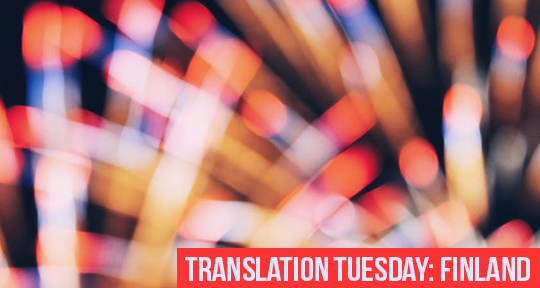This Translation Tuesday, we present fragments of poetry found embedded in text and in testimony, pried from their source and polished to a sheen. Two poems by Finnish poet Antti Salminen, translated by José Luis Rico, “Autoethnographical Sketch of the Pipe” and “Reminiscence of Settlement History” , evoke a diamond mine deep in the Siberian hinterland, a cold hell: the frost, the sludge, the desolation of the frozen pit, the hasty brutish ingenuity of the Soviet mining engineers, and the miners’ deadly toil.
Autoethnographical Sketch of the Pipe, Fragment from the Second Chapter
Mir, Mirny, open pit mine, mineshaft. 62º31 45.95 N 113º59 36.74 E: funnel-shaped ravine and artificial crater, the abyss the last people dug for themselves.
A small airport with its brief runway on the massive mining landscape’s earthwork. A glider hangar. There, where a small mining town had been, now a silent, mossy, pebble beach made of cement. No building was left standing, the purpose being to render the place as repulsive as possible for at least a thousand years. The magnitude of the risk was unknown, but there was no alternative.
When the place was initially dug, says Junifer, the mining engineers melted the winter frost from the ground with turbojets. There’s no rush to go further down, we’re already at the bottom. Work continues underground, slowly. Now we work with our hands, in small gestures. The shovels are less than weapons, and the excavators sit idle like a mighty beast’s skeleton at an open-air museum.
The serpentine road leads downward to the funnel, down to the bottom, to the pond’s gravelly beach. The road is ridden with sinkholes, which are patched and driven over however possible. In the molten-ground season: sludge, sludge everywhere. From October to April the amount of ice is impossible. The struggle against the ground frost can’t be won. But when you live through a permanent sinkhole, you learn to harness gravity.
Reminiscence of Settlement History, Unknown Informant
And we were building all the time. Everything we needed and everything which sprung out of our hands unexpectedly, architectural solutions of a mind which one random day must learn to inhabit hell and its lurking sphere of influence as a home.
Insurgent, effective, obedient stronghold: sheds, huts, depots, field kitchens, air-raid shelters, woodsheds, paths, service roads, countless dugouts, trenches, and fortified stations. Watch towers, toilets, provisional cabins, fields, lanes, tent villages… and we built it all. We only made a few things from wood (although soon the carving of enemy corpses found its supporters, and the supporters their reasons). Rather, we used all the materials abandoned in the mines. People leave so much behind, and quite unwillingly. From one 30-ton earthmover you can get abundant materials of variable quality and even components if the pioneering spirit is high. But above all you had to love digging, to analyze the sediments’ solidity, to accept the constant risk of crumbling. The majority of our most eager workers got their funeral blessings when still probably alive.
And as long as there were abundant explosives, every now and then a comrade would lose a limb or two, every now and then wounds would burst open like gaping mouths – and thus to this today the trepanation of officers reminds us of the resolve to plant a hefty dynamite load in a spot no one else would dare to place it. We built and in the spring of the fourth year we were done, come what may.
And it did come. The war.
Translated from the Finnish by José Luis Rico
Antti Salminen (b. 1983) is a Finnish philosopher, poet, and theorist. His work is marked by a deft balance between strictly aesthetic concerns and contemporary material challenges, such as dependence on hydrocarbons and the possibilities of self-sustainability. Lomonosovin moottori (Lomonosov’s Engine)—the first title in Salminen’s Conditions Trilogy—won the Kalevi Jäntti Prize (in the poetry category) and the Tähtivaeltaja Award (in the speculative fiction category) in 2014. The excerpts showcased here belong to MIR (2018), the trilogy’s second title, shortlisted for the Runeberg Prize and included in Helsingin Sanomat’s “Finland’s 100 Best Books of the 2000s.” Salminen works as a professor of creative writing at the University of the Arts Helsinki and is also an adjunct professor at the University of Tampere. Summa Tunguska (2024) is his most recent book and the trilogy’s last title.
José Luis Rico (Ciudad Juárez, Mexico, 1987) is a Helsinki-based poet and translator from Northern Mexico. He holds an MFA in Creative Writing from New York University and is currently the president of Sivuvalo Platform, a non-profit that promotes the integration of migrant writers in Finland and the visibility of Finnish literature in the Americas. Rico has published several poetry books in Spanish, some loose poems here and there in English, and has curated a few poetry anthologies. He has translated authors like Michel Butor, Annie Ernaux, Ludovic Halévy, from French, and others like Sini Silveri, Juha Rautio and Tiina Lehikoinen from Finnish. Cute Person Stuff, his latest poetry chapbook, will appear under Pitzilein Books in the fall 2025.
*****
Read more on the Asymptote blog:

